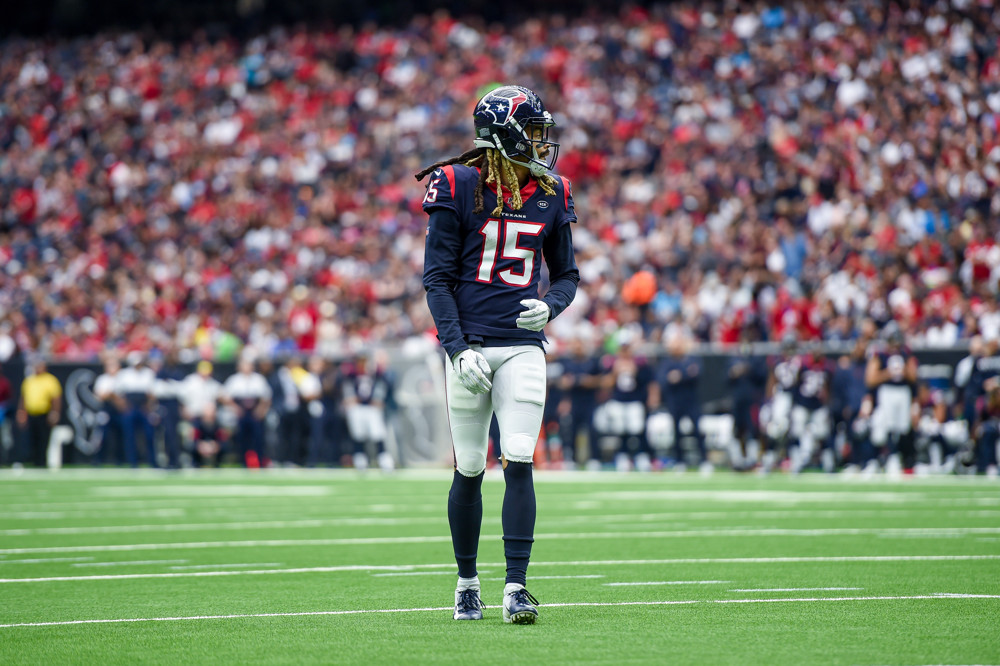In Best Ball, simply picking the right players is not a realistic strategy. We also need to consider the implications of the no-transaction format.
A big part of that is roster construction. In other words, how many players at each position should we draft? It’s a simple question with a complicated answer for a couple reasons.
First, our decisions should be dynamic to our positional strength — which is a function of draft capital. If our QB1 is Patrick Mahomes, he’s very likely to be the quarterback who counts in our lineup an overwhelming majority of weeks. In that scenario, selecting just two QBs (with different bye weeks of course) can be correct. But if the first QB we draft is Teddy Bridgewater, then we undoubtedly need to take three.
Second, we need to account for positional volatility. The weekly range of outcomes at wide receiver is wider than at running back, tight end and quarterback. As you’ll see below, wide receivers will be our most-rostered position.
Finally, we need to consider payout implications. Most of the prize pool is paid out to a few winners at the top. A “go big or go home” type approach generally is how we should be playing. We get nothing for finishing 3rd place in our initial 12-man group, so we shouldn’t be worried about taking on extra risk if it means our chances of an extremely strong team are slightly improved. Note that this approach is counterintuitive to most season-long fantasy players, while DFS players tend to be more comfortable with it given the nature of DFS tournaments.
Editor’s Note: Our Draft Kit is just $34.99 and comes with a $25 coupon to use in any FFPC league. Click here for more details.
DRAFTKINGS FORMAT
* 12-team leagues, 20-player rosters
* Full-PPR, bonuses for 300-yard pass games and 100-yard rush/receiving games. No D or K
* Starting lineup: QB, RB, RB, WR, WR, WR, TE, FLEX
DRAFTKINGS STRATEGY NOTES
* The bonuses for 300-yard pass game and 100-yard receiving games make stacking even more valuable. For more on stacking in season-long click here and for more on stacking in Best Ball listen to Episode 84 here.
* We do not want to handcuff our running backs. For example, drafting both Ezekiel Elliott and Tony Pollard blocks in every week of the season. But if we draft Ezekiel Elliott and Alexander Mattison, then we have a clear path to two playable scores if Dalvin Cook misses time.
* We do not recommend making roster adjustments for player-level volatility. In other words, bumping up a player like DeSean Jackson or Marquise Brown for the format is a bit of fancy play syndrome. The field will overrate their ability to identify these kind of players, therefore inflating average draft position.
* At the time of this writing, there are limited DraftKings Best Ball Rankings available online. That literally means our opponents will be using rankings not formatted for this contest, or worse, using the DraftKings default rankings while they draft. We can create a massive edge by being aware of these defaults for ADP reasons, and using actual rankings customized for this format. If you’re interested in our rankings, be sure to check our Draft Kit, which is only $34.99 and comes with everything we think you need to prepare for season-long fantasy drafts. A full list of everything you can find in our Draft Kit can be viewed here.
HOW MANY SHOULD I TAKE AT EACH POSITION?
In order to solve the question of positional allocation, we took a data-driven approach. We looked at the last three years’ results in other best ball formats, then simulated roughly 26,000 teams based on average draft position (ADP) in search of winning roster constructions. We’ve modified our findings for the DraftKings Best Ball format.
QUARTERBACKS
Recommendation: Take 2-3
Analysis: When deciding whether to take two or three QBs, keep draft capital in mind. If you do invest in QB in the first six rounds, we recommend skewing toward 2-QB builds. A 2-QB roster of Dak Prescott and Joe Burrow is correct since Dak is an early-round QB. But a 2-QB roster of Ben Roethlisberger and Ryan Tannehill is not recommended as they are both late-round QBs. We’d want to add a Burrow or Bridgewater type to that for a 3-QB construction. We should lean more towards three QB builds in this format vs. Yahoo’s or FFPC’s as we do have 12 bench spots.
RUNNING BACKS
Recommendation: Take 4-7
Analysis: The data shows that the market is over-investing in the RB position. Winning roster trends included taking RBs in the early rounds, but not taking a lot of them. Mike Leone investigated that here. Of course that strategy opens ourselves up to downside at the most injury-prone (and worst job security) position, but we are not overly concerned with floor in this format. We are going for first place.
Note that the usability rate drops off far steeper at RB vs. WR. Generally speaking, we do not want our double-digit round flier selections to be at RB. We want our RBs early in Best Ball, but want fewer of them than the field will take. Furthermore, we do not want to block our upside by handcuffing any of our early-round RBs.
Again, if you invest heavily in RBs in the early rounds, you should invest less later. As a general rule, if you take at least 2 RBs in the first four rounds, we’d typically stay on the lower end of our suggested RB range (4-6) overall. If you end up with a draft spot that forces you to miss the Top 6 RBs, you might be forced into a modified Zero RB approach, in which case we suggest drafting 6-7 RBs.
WIDE RECEIVERS
Recommendation: Take 8-10
Analysis: The big-play nature of the WR position breeds volatility. Whereas RBs rely on volume to create usable scores, WRs can get it done on just a handful of targets. And since the Best Ball format doesn’t force us to identify exactly when those big plays will happen, we can gain more value from piling on later-round options. Our data showed that limiting WR selections to two or three in the first five rounds was optimal.
As noted in the intro, DraftKings’ format accentuates stacking even more than other formats. When your wide receiver gets the 100-yard bonus, there’s a very good chance his quarterback will get the 300-yard bonus as well. Given these 20-player rosters and the payout structure of the tournaments, we’d be trying to land on two double-stacks of QBs and pass-catchers.
TIGHT ENDS
Recommendation: Take 2-3
Analysis: The tight end position strategy is similar to quarterback. If we invest in a Travis Kelce, George Kittle, Zach Ertz or Mark Andrews, optimal construction skews toward drafting just two total TEs. If we wait until the Rob Gronkowski tier or later, we need to take three tight ends. My personal preferred route this year is to take three tight ends from Silva’s Tier 5, which includes Noah Fant, Dallas Goedert, Ian Thomas, Mike Gesicki and TJ Hockenson.



